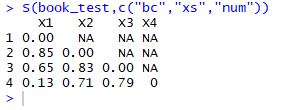First, the Experiment:
Write code s = DisFun (T, Sign), where T is a data set, Sign attribute type, d is a similarity matrix
Second, the source code:
#num数值型
#fdc表示非对称二元
#dc表示对称二元
#bc表示标称属性
#p表示指示符
#xs表示序数属性
S = function(T,Sign){
d = data.frame(matrix(NA,nrow(T),nrow(T))) #相异性矩阵
distance = c() #距离
p = c() #指示符
G = T
for(i in 1:nrow(T)){
for(j in 1:i){
if(i == j){
d[i,j]=0
}
else{
for(f in 1:ncol(T)){
if(T[i,f] == 0&T[j,f] == 0&Sign[f]=='fdc'){
p[f] = 0
}
else if(is.na(T[i,f])|is.na(T[j,f])){
p[f] = 0
}
else{
p[f] = 1
}
#相异性计算
if(is.na(T[i,f])|is.na(T[j,f])){ # xif或xjf缺失
distance[f] = 0
}else if(Sign[f]=='num'){ #数值型
distance[f] = abs(T[i,f]-T[j,f])/(max(T[,f])-min(T[,f]))
}
else if(Sign[f] =='fdc'|Sign[f] =='dc'|Sign[f] =='bc'){ #标称或者二元(对称和非对称)
if( T[i,f] == T[j,f]){
distance[f] = 0
}else{
distance[f] = 1
}
}
else if(Sign[f]=='xs'){ #序数型
z = (G[,f]-1)/(max(G[,f])-1)
T[,f] = z #将原f列替换成映射
distance[f] = abs(T[i,f]-T[j,f])/(max(T[,f])-min(T[,f]))
}
}
d[i,j] = round(sum(p*distance)/sum(p),2)
}
}
}
return(d)
}
#1、书上例子
test1<-c("A","B","C","A") #标称
test2<-c("优秀","一般","良好","优秀") #序数
test3<-c(45,22,64,28) #数值
book_test<-data.frame(test1,test2,test3)
book_test[,2]<-c(3,1,2,3)
S(book_test,c("bc","xs","num"))
#2、举个栗子
t1 = c(125,48,57,147,58) #数值
t2 = c("优秀","良好","及格","补考","中等") #序数
t3 = c(1,0,1,1,0)
t4<-c("男","女","女","男","女")
t5 = c("长方形","圆形","三角形","菱形","三角形")
mytest = data.frame(t1,t2,t3,t4,t5)
mytest[,2] = c(5,4,2,1,3)
Sign = c("num","xs","fdc","dc","bc")
S(mytest,Sign)
Third, the results:
Examples of textbooks

Own example

